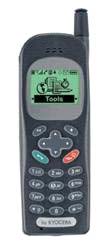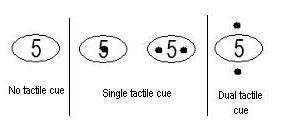Measuring Effectiveness of Tactile Landmarks on Telecommunication Device Dialpads
Regina K. Nelson, MS and Gregg C. Vanderheiden, PhD
ABSTRACT
Tactile landmarks on telephone keypads provide essential information when dialing a phone without the benefit of visual cues. This study considered the tactile nib that is used to mark the 5-key. The number of nibs and their placement were manipulated on four wireless phones. Twenty participants, including both blind and sighted persons who were restricted from using their vision, dialed auditorily-presented phone numbers. The results showed that the presence of a nib improves dialing time. It was also found that multiple nibs functioning as a single tactile cue improved dialing time when compared to a dual tactile cue.
Keywords:
accessibility; tactile cues; telecommunications; universal design
INTRODUCTION
Recent regulatory trends have focused attention on how tactile cues improve accessibility of telecommunication, electronic and information technology. While many users are able to visually search a keypad and dial a sequence of digits through a combination of visual and kinesthetic feedback, some users navigate a keypad without the advantage of visual cues. The dialing task is further complicated for those who can't see as more controls are added to a smaller area which is often the case with wireless technology. The Telecommunication Act Accessibility Guidelines provide that input, control, and mechanical functions shall be locatable, and operable without vision, providing at least one mode that does not require user vision [1]. For phones, that often includes placing a nib to mark the 5-key. Different manufacturers have chosen different approaches. Single and multiple nibs have been used. Nibs have been placed on the 5-key itself and in the area between the 5-key and surrounding keys. There has been a paucity of research to help guide researchers, companies or policy makers in evaluating the relative efficiency of the different approaches. This research examined dialing performance on four phones with different nib configurations representing single and dual tactile cues as well as a no nib control condition.
METHODOLOGY
 |
 |
Kyocera QCP-2035 phones were adapted to create four different configurations characterized by nib placement: 1) no nib; 2) one nib on the 5-key; 3) two nibs on the 5-key; and 4) two nibs, one above and one below the 5-key (see Figure 1). The single tactile cue was represented both by the configuration with the single on-key nib and also by two on-key nibs placed closely enough together so they could be detected simultaneously. The off-key nib configuration represented a dual tactile cue (i.e. the person had to find the two nibs separately and identify the 5-key as the key that fell between them.)
Twenty individuals participated in the study. Ten of the participants self-reported that they were totally blind or blind with light perception. Ten of the participants were sighted, reporting sufficient vision to read newspaper print. A mixed experimental design was utilized with vision status the only between subject factor and three within-subject factors: nib configuration, lead digit of phone number (five or not a five), and replication. Three dependent variables were measured: time to start dialing, interdigit average, and number of errors.
The participants dialed ten 7-digit numbers on each of the four phones. To reduce working memory load, the phone numbers used in this study were created using easily recalled sets of digits [2]. The numbers were presented auditorily following a consistent presentation pattern. The phone was placed in a draped testing box to prevent the participants from using visual cues to dial the phone.
RESULTS
 |
The data were analyzed using the nonparametric Friedman, Mann-Whitney, and Wilcoxon Matched-Pairs tests with level of significance set at p < 0.05.
For the time to start dialing response variable there was a significant effect for nib configuration [? 2 (3, N = 20) = 18.78; p < 0.001]. Planned comparisons of the nib configurations were tested using the Holm procedure for multiple comparisons [3]. There were several significant findings. Participants began to dial 13.6% faster on the phone with two nibs on the key than on the no nib control condition [Z = -2.501; p < 0.0125]. An effect was found between the off-key (dual tactile) condition and both the one and two on-key (single tactile) conditions. The time to start dialing was 24.3% faster with one nib on the key [Z = -3.696; p < 0.0062] and 23.0% faster with two on-key nibs than when the nibs were located above and below the key [Z = -3.696; p < 0.0062].
|
No nib |
One on-key nib |
Two on-key nibs |
Two off-key nibs |
Time to Start Dialing |
||||
|---|---|---|---|---|
Median [sec] |
2.79 |
2.37 |
2.41 |
3.13 |
Interquartile Range [sec] |
1.57 |
1.33 |
1.65 |
1.09 |
Interdigit Average |
||||
Median [sec] |
0.80 |
0.73 |
0.80 |
0.93 |
Interquartile Range [sec] |
0.60 |
0.37 |
0.37 |
0.34 |
Nib configuration was significant for the interdigit average response variable [? 2 (3, N = 20) = 24.9; p < 0.001]. Further planned comparisons yielded several significant findings. The interdigit average was 8.7% shorter when the phone had a single nib on the 5-key than when there was no nib [Z = -3.584; p < 0.0062]. The interdigit average was 14% longer when the nibs were placed above and below the key than when there was no nib at all [Z = -2.464; p < 0.025]. Interdigit averages were 21.5% shorter [Z = -3.808; p < 0.0062] with one on-key nib (single tactile) and 14% shorter [Z = -3.360; p < 0.0125] with two on-key nibs (single tactile) than when the nibs were located off the key (dual tactile). For the Lead Digit effect, the interdigit average for phone numbers that began on the marked 5-key was 13% shorter than for phone numbers that began on an unmarked key [? 2 (1, N = 20) = 12.80; p < 0.001].
DISCUSSION
Although there has been little data-based guidance in relation to nib placement, heuristics used in wireless phone design have suggested that a raised nib on the 5-key provides the best tactile cue [4]. The results of this study provide evidence to support that guideline and further suggest that it is the use of a single tactile cue, not just a single raised nib on the 5-key, that leads to increased dialing performance.
The presence of one or more nibs on the top of the 5-key (configured as a single tactile cue) increased dialing speed. The results further demonstrated that dialing performance decreased when a dual tactile cue was used. The interdigit average for the dual tactile condition was actually 14% longer than when there was no nib present at all. This suggests that dual tactile cues, like those used in this study above and below the key, might actually delay locating the marked key. The participants' comments supported this association. The off-key nib condition was the least preferred.
The number of nibs is not the deciding factor for identification as a single or dual tactile cue. Although this design incorporated two nibs placed above and below the 5-key to represent a dual tactile cue, any time that the nibs are placed far enough apart that they are not automatically identified together they should be considered a dual or multiple tactile cue. A more precise determination of this critical distance may be identified with future research on how individuals use tactile nibs as orienting cues. The distance may not need to be as large if a sweeping type motion is used to find the nib as opposed to simply placing the thumb or finger on and off the keypad at different locations to search for the tactile marker.
This research demonstrated that users can benefit from having a single tactile cue marking the 5-key when unable to visually screen the keypad to dial a phone number. The single nib scored better in this experiment, but the difference for the double nib on top of the key was not statistically significant. The use of two nibs on top of the 5-key, with the nibs located tightly on either side of the 5 digit may be an effective way to provide a single, effective tactile cue without having the cue interfere with printing of the 5 numeral on the key.
REFERENCES
- Telecommunication Act Accessibility Guidelines, 36 C.F.R. pt. 1193 (1998)
- Chapanis, A. & Moulden, J.V. (1990). Short-term memory for numbers. Human Factors 32(2) 123-137.
- Holm, S. (1979). A simple sequentially rejective multiple test procedure. Scandinavian Journal of Statistics . 6: 65-70.
- Vanderheiden, G.C. (1999) Trace Center Reference Design for Cell Phones. Retrieved December 22, 2002 from http://trace.wisc.edu/docs/phones/index.htm
ACKNOWLEDGEMENT
This work was (is) primarily funded by the National Institute on Disability and Rehabilitation Research (NIDRR) through the U.S. Dept. of Education, grant numbers H133E990006 & & H133E980008.
The opinions expressed here do not necessarily represent the policy of the U.S. Dept. of Education
CONTACT
Regina Nelson, M.S., nelson@trace.wisc.edu
Gregg Vanderheiden, Ph.D. gv@trace.wisc.edu
Trace Research and Development Center,
2107 Engineering Centers
Bldg,
1550 Engineering Drive, Madison, WI 53706
